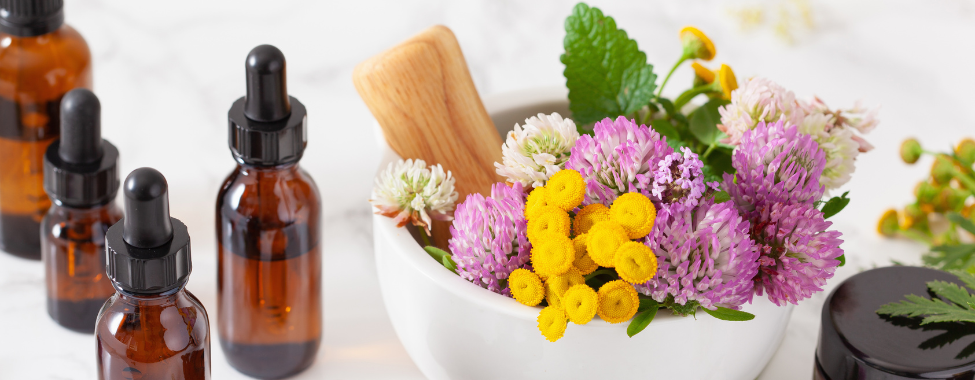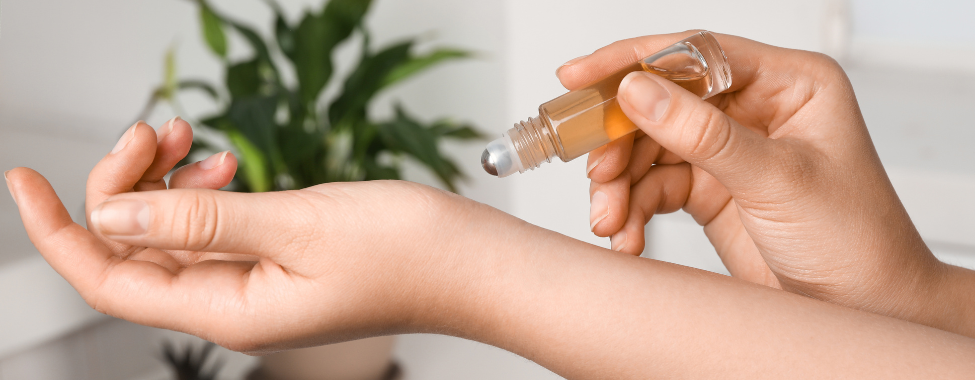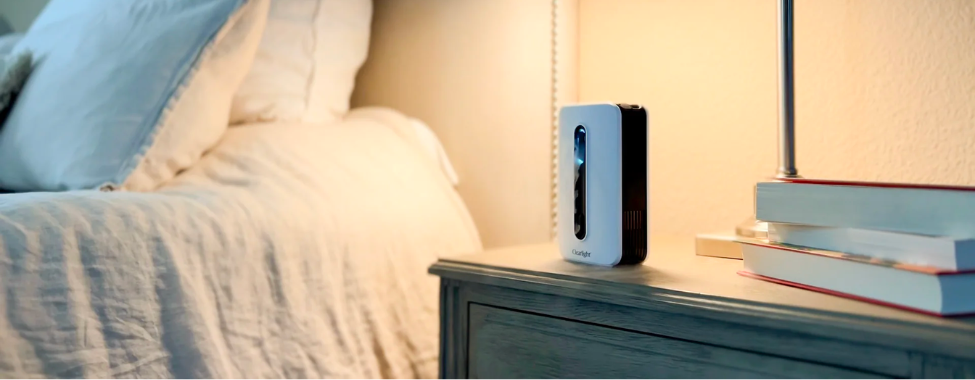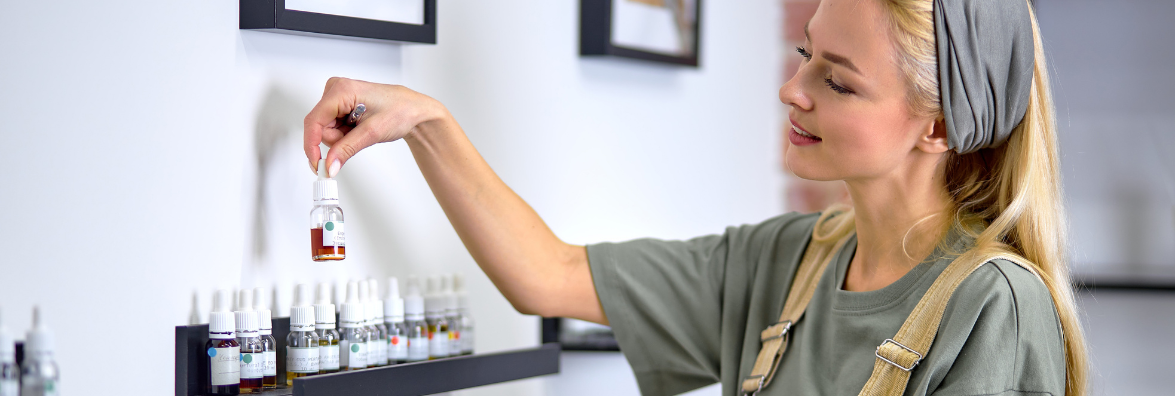- 19 Oct, 2023
- /
- Clearlight Infrared Saunas
- /
- No Comments
Essential Oil Uses & The Benefits of Aromatherapy
In a world often filled with hustle and bustle, it’s no wonder many of us look for ways to boost our well-being. Enter essential oils and the practice of aromatherapy, age-old remedies that harness the aromatic essence of plants to help enhance our physical, emotional, and mental health. From promoting relaxation to boosting mood and improving overall well-being, aromatherapy has become an essential part of many people’s daily routines.
Whether you’re a seasoned enthusiast or just beginning to explore the world of essential oils, read on to learn more about essential oils, practical applications, and DIY recipes that can help you use the power of nature’s most fragrant gifts for a healthier, more balanced you.

What are Essential Oils?
Essential oils are highly concentrated, aromatic compounds extracted from various parts of plants, including leaves, stems, flowers, and roots. These oils capture the natural essence and fragrance of the plants, making them potent tools for a wide range of purposes, from therapeutic to cosmetic.
Aromatherapy, on the other hand, is the practice of using these essential oils to promote physical, psychological, and emotional well-being. It has a rich history dating back thousands of years. It finds its roots in ancient civilizations like Egypt, where essential oils were used in religious rituals and embalming. The Greeks and Romans valued essential oils for their medicinal properties and luxurious scents.
Throughout history, essential oils have been cherished for their holistic health benefits, offering relief from physical ailments, emotional stress, and even spiritual enhancement. In modern times, the popularity of essential oils continues to rise as people enjoy the natural benefits they provide.
The Benefits of Aromatherapy
Physical Benefits
- Boosted Blood Circulation: Certain essential oils, such as rosemary, cinnamon, and ginger, can help improve blood circulation, which can have a positive impact on overall health.
- Improved Sleep: Essential oils like lavender and chamomile have calming properties that can promote better sleep quality and alleviate insomnia.
- Skin Care: Essential oils like cedarwood and tea tree, have anti-inflammatory and antimicrobial properties, making them beneficial for skin conditions such as acne, eczema, and dryness.
- Boosting the Immune System: Essential oils like tea tree and eucalyptus have natural antibacterial properties that can help strengthen the immune system by helping fight off infections.
Emotional and Mental Benefits
- Stress Reduction: Aromatherapy can help reduce stress and anxiety levels by promoting relaxation and calming the mind. Oils like lavender, bergamot, and ylang-ylang are known for their stress-relieving properties.
- Mood Enhancement: Essential oils can have an effect on mood and emotions. Oils like citrus (such as lemon and orange) and peppermint are known for their uplifting properties and can improve mood and energy levels.
- Mental Clarity: Some essential oils, such as rosemary, orange, and peppermint, have stimulating properties that can help enhance mental clarity for better focus, concentration, and mental alertness.

Essential Oil Safety Precautions
When using essential oils, it is essential to consider safety precautions. Always follow recommended dilution ratios, perform patch tests, and consult a doctor if you have any concerns, especially if you are pregnant, nursing, or have underlying health conditions. Additionally, some essential oils such as eucalyptus oil, tea tree oil, cinnamon, citrus, peppermint, pine, wintergreen, and ylang-ylang can be dangerous for pets, so make sure to research in advance.
It’s also advised to exercise caution when using essential oils around children, as children can be more sensitive to essential oils than adults. The recommended number of drops can vary depending on the child’s age and the specific essential oil being used. Here are some general guidelines:
- 0-6 months: It’s typically recommended to avoid using essential oils in a diffuser around babies under six months old, as their respiratory systems are still developing, and they can be very sensitive to strong scents.
- 6 months – 2 years: For this age group, it’s best to be extremely cautious. If you decide to use a diffuser, use a minimal amount of essential oil, such as 1-2 drops, and ensure good ventilation in the room. Always monitor the child for any adverse reactions.
- 2-5 years: For children in this age range, you can use a slightly higher amount of essential oil, typically 2-3 drops in a diffuser. Again, ensure proper ventilation, and watch for any signs of discomfort or irritation.
- 6-12 years: You can use a bit more essential oil for this age group, usually around 3-5 drops in a diffuser. Always dilute essential oils if necessary and choose oils that are safe for children.
- 13+ years: Teenagers can generally use essential oils in the same way as adults, following the recommended guidelines for adult use.
Keep in mind these general guidelines, but also consider the individual child’s sensitivity and any specific health concerns they may have. It’s crucial to use child-friendly essential oils and to always err on the side of caution, starting with fewer drops and increasing the amount if needed. Additionally, it’s a good practice to consult with a pediatrician or a qualified aromatherapist for guidance, especially if your child has any underlying health conditions or allergies.
How to Use Essential Oils
There are several ways to use essential oils depending on your preference and desired effect. One of the most common ways to use essential oils is by inhalation. Adding a few drops of essential oil to a bowl of hot water and inhaling the steam can provide quick and easy relief. Using an essential oil diffuser is one of the most popular ways to enjoy the benefits of aromatherapy. Diffusers disperse essential oils into the air, allowing you to inhale the fragrance and experience the therapeutic effects.
The Clearlight® AROMA ONE® essential oil diffuser uses ultrasonic, high-frequency technology to create a fine mist from water and the high-quality essential oils of your choice. Running 4 hours when plugged in or 2.5 hours with its optional battery, this portable essential oil diffuser gives you the ultimate aromatherapy experience wherever you go, whether you place it bedside to help with sleep, on your desk for mid-day work focus, or in your infrared sauna for a true health and wellness sanctuary.
You can also apply essential oils topically. Essential oils should always be diluted before applying them to the skin. Diluting essential oils with a carrier oil, such as coconut oil, jojoba, or almond oil, helps reduce the risk of skin irritation and allows for better absorption. Once diluted, applying essential oils to specific areas of the body can help target specific ailments. For example, applying peppermint oil to the temples can help alleviate headaches, while lavender oil on the wrists can promote relaxation.
Essential oils can also be applied to home uses. Essential oils like tea tree oil and lemon oil are excellent natural alternatives to conventional cleaning products. Adding a few drops to your homemade cleaning solutions can provide a fresh and clean scent while offering antimicrobial properties. You can also apply them to your bath and skin products. Try adding a few drops of essential oils to your bathwater or incorporating them into your skincare routine can provide a spa-like experience and offer various benefits to your skin.

Essential Oils for Common Ailments
In addition to the overall benefits of aromatherapy, specific essential oils can target common ailments.
For example, peppermint oil is known for its cooling and analgesic properties, which can help alleviate headaches and migraines when applied topically to the temples or forehead. Eucalyptus oil can be used as a decongestant due to its anti-inflammatory properties that can help relieve nasal congestion caused by allergies or colds. It can be inhaled or added to a diffuser. For anxiety and stress, lavender oil is renowned for its calming effects on the nervous system. Its soothing aroma can help reduce anxiety and promote relaxation. It can be used in diffusers, applied topically, or added to a warm bath.
Essential Oil Blends and Recipes
Creating your own essential oil blends allows you to tailor the aromatherapy experience to your specific needs. Here are a few examples of blends and their benefits:
- Relaxation blend for stress relief: Combine lavender, chamomile, and bergamot oils for a soothing and calming blend that promotes relaxation and reduces stress.
- Immune-boosting blend: Create a blend of tea tree, eucalyptus, peppermint, and lemon oils to help strengthen the immune system and fight off seasonal illnesses and allergies.
- Refreshing blend to start off the morning: Mix peppermint, rosemary, and citrus oils for an invigorating blend that helps wake up the senses and promotes mental alertness.
- Energizing blend for focus during the day: Combine lemon, peppermint, and basil oils to create a revitalizing blend that enhances focus and concentration.
- Uplifting blend for mood enhancement: Mix lemon, rosemary, and ylang-ylang oils for an uplifting blend of essential oils for better mood.
- Headache relief blend: Dilute a blend of peppermint, lavender, and eucalyptus oils, and apply to your temples and neck for headache relief.
- Sleep-inducing blend for a restful night: Create a blend of lavender, cedarwood, and marjoram oils to promote relaxation and improve sleep quality.
- Natural cleaning solution: Combine lemon and tea tree oils with white vinegar and oil for an effective and eco-friendly cleaning solution.
- Nourishing facial serum: Mix frankincense, lavender, and tea tree oils with jojoba oil, and apply a few drops to your face and neck before bedtime.

Using Aromatherapy at Home
Aromatherapy isn’t just reserved for spa visits or special occasions, it can also be seamlessly integrated into your daily life to enhance your overall well-being.
Kickstart your day with invigorating essential oils like citrus (e.g., orange or grapefruit) or peppermint. Diffuse these scents while you prepare your morning coffee or meditate to awaken your senses and promote mental clarity. When the midday slump hits, turn to essential oils like rosemary or eucalyptus to help you stay focused and energized. Consider using a portable diffuser for an instant pick-me-up at your desk. And as the day winds down, transition into a state of relaxation with calming scents like lavender or chamomile. Incorporate them into your bedtime routine by diffusing them in your bedroom or adding a few drops to a warm bath for a peaceful night’s sleep.
Infrared Sauna Aromatherapy
For an added health boost, consider incorporating aromatherapy into your infrared sauna sessions. Infrared saunas, known for their own long list of health benefits, can be elevated with the use of essential oils. Essential oils are highly concentrated, so you only need a few drops to add fragrance to your sauna. Using too much oil can create an overpowering scent and potentially cause irritation. When choosing oils, ensure you are using pure, high-quality essential oils, and avoid synthetic or adulterated options.
Be mindful of the people using the sauna with you. Some individuals may be sensitive or allergic to certain essential oils, so it’s a good idea to ask for their preferences or any concerns.
When using essential oils in a sauna, ensure you have adequate ventilation to prevent the buildup of steam and essential oil vapors. Proper ventilation helps maintain a comfortable and safe sauna environment. do not apply them directly to the sauna heater or any hot surfaces, as this can lead to combustion or fire hazards. Instead, use a method that allows you to disperse the aroma safely.
The Aroma One aromatherapy diffuser can be easily placed in your infrared sauna for a spa-like experience right at home. If you do not have a diffuser, you can simply add a drop or two of your chosen oil to a cloth, porous stone, aroma pad, or cotton ball and place it inside the sauna and away from the heat source. As the sauna warms up, the oils will disperse into the air, providing an immersive and rejuvenating experience that can aid in detoxification, stress relief, and improved overall health.
Applying Essential Oils to Your Wellness Routine
Aromatherapy and essential oils offer a holistic approach to well-being, addressing both physical and mental health. From reducing stress and promoting relaxation to alleviating ailments and enhancing mood, the benefits of aromatherapy are vast. By exploring and experimenting with different essential oils and blends, you can discover what works best for you and create a personalized aromatherapy routine.
Remember to always prioritize safety by following proper dilution ratios, performing patch tests, and seeking professional advice when needed. Embrace the power of aromatherapy and let the fragrant essences of essential oils enhance your everyday wellness journey!
 Canada
Canada Australia
Australia New Zealand
New Zealand Germany
Germany UK
UK EU
EU Ireland
Ireland Malaysia
Malaysia China
China

